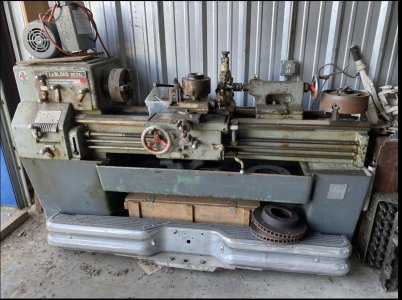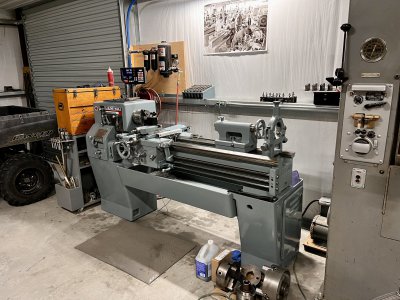I just finished “restoring“ my 1958 LeBlond Regal 13x42. I added a new Aloris tool post and a Newall DRO to make it more user friendly. It was a bit of of basket case when I got it, had not been run for 20+ years and not well taken care of at times in its past. I could not even run it when I went to look at it, but the gears looked good and everything moved just fine and it came with a rotary phase converter, taper, steady and follow-rest… the downside of living on the gulf coast is that it’s slim pickings on nice lathes from the 50’s and 60’s…. So I drove 6 hours north to pick this one up……
I stripped it down to bare metal and resprayed with PPG industrial primer and industrial topcoat that I had color matched. Of course the more you dig into it, the more things you find that are not as you hoped… so I just finished making a new alloy cross feed screw and bronze nut for it, major improvement. I had nearly one full turn of backlash, now I have 10 thou. My surface finish did not really improve (I was getting excellent surface finish even with tons of backlash in it), but it is much more satisfying to use now. After removing the backlash in the cross feed, I now notice the backlash in the apron hand wheel, or Z axis, so plan to make new pinion shaft/gears for the apron (the one that is attached to the hand wheel and the one that engages the rack). Has anyone out there replaced these before? Any advise before I dive in?
One thing I quickly figured out when making parts for your lathe is that you have to take parts off to measure them, then put them back to make their replacements, and go back and forth again when they don’t fit just right….
I dropped in before and after photos..
I stripped it down to bare metal and resprayed with PPG industrial primer and industrial topcoat that I had color matched. Of course the more you dig into it, the more things you find that are not as you hoped… so I just finished making a new alloy cross feed screw and bronze nut for it, major improvement. I had nearly one full turn of backlash, now I have 10 thou. My surface finish did not really improve (I was getting excellent surface finish even with tons of backlash in it), but it is much more satisfying to use now. After removing the backlash in the cross feed, I now notice the backlash in the apron hand wheel, or Z axis, so plan to make new pinion shaft/gears for the apron (the one that is attached to the hand wheel and the one that engages the rack). Has anyone out there replaced these before? Any advise before I dive in?
One thing I quickly figured out when making parts for your lathe is that you have to take parts off to measure them, then put them back to make their replacements, and go back and forth again when they don’t fit just right….
I dropped in before and after photos..




